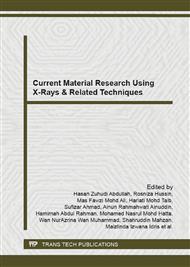[1]
S. Jones, C.Yuan. Advances in shell moulding for investment casting, Journal Mater. Process. Technology.135 (2003) 258-265.
DOI: 10.1016/s0924-0136(02)00907-x
Google Scholar
[2]
Z.Harun, N.M. Nawi, M.F. Batcha, D.T. Gethin. Modeling of Layering Ceramic Shell Mould, Applied Mechanics and Materials. 232 (2012) 548-552.
DOI: 10.4028/www.scientific.net/amm.232.548
Google Scholar
[3]
Z.Harun, D.T. Gethin. Drying (Consolidation) Porous Ceramic By considering the microscopic pore temperature gradient, Applied Mechanics and Materials. 147 (2012) 210-214.
DOI: 10.4028/www.scientific.net/amm.147.210
Google Scholar
[4]
Z.Harun, D.T. Gethin. Drying Simulation of Ceramic Shell Build up Process, in Proceedings 2nd Asia International Conference: on Modelling and Simulation (AMS 2008) 794-799 (2008) art.no.4530577.
DOI: 10.1109/ams.2008.109
Google Scholar
[5]
J.M. Guerra. Factors affecting shell strength and the effect of dry time on shell strength presented at the 22nd EICF Conference (1992).
Google Scholar
[6]
H. Tomaszewski, H. Weglar, A. Wajler, M. Boniecki, D. Kalinski. Multilayer ceramic composites with high failure resistance, Journal of the European Ceramic Society. 27 (2007)1373–1377.
DOI: 10.1016/j.jeurceramsoc.2006.04.030
Google Scholar
[7]
C.Yuan, S. Jones and S. Blackburn. The influence of autoclave steam on polymer and organic fibre modified ceramic shells, Journal of the European Ceramic Society. 25 (2005) 1081–1087.
DOI: 10.1016/j.jeurceramsoc.2004.04.011
Google Scholar
[8]
S. Jones, M.R. Jolly, S.Blackburn, J.C. Gebelin, A. Cendrowicz, K. Lewis. Effect of moisture upon mechanical properties of ceramic moulds during high pressure steam dewaxing, Material Science and Technology. 19 (2003) 907-914.
DOI: 10.1179/026708303225004297
Google Scholar
[9]
M. Grzybowski, S.P. Shah. Shrinkage cracking of fiber reinfroced concrete, ACI Material Journal. 87(1990) 138-148.
Google Scholar
[10]
R.N. Swammy, H. Stavirides. Influence of fiber reinforcement on restrained shrinkage cracking, ACI Journal.76 (1979) 443-460.
DOI: 10.14359/6954
Google Scholar
[11]
P. N. Balagaru, S.P. Shah. Fiber reinforced composites, New York McGraw-Hill, 1992.
Google Scholar
[12]
W.J. Weiss, W. Yang, S.P. Shah. Restrained shrinkage cracking in concrete, in Sixth International Purdue Conference on Concret Pavement Design and Materials for High Performance (1997).
Google Scholar
[13]
A. D. Kington. Shell moulds for casting metals, England Patent, 1991.
Google Scholar
[14]
B. S. Ndazi, Karlsson, S.,Tesha, C.W. Nyahumwa. Chemical and physical modifications of rice husks for use as composite panels, Composites. A 38 (2007) 925-935.
DOI: 10.1016/j.compositesa.2006.07.004
Google Scholar
[15]
Z. Harun, N. H. Kamarudin, N. A. Badarulzaman. Key Engineering Materials. 471-472 (2011) 922-927.
DOI: 10.4028/www.scientific.net/kem.471-472.922
Google Scholar
[16]
M.S. Sreekala, S.Thomas. Effect of fibre surface modification on water-sorption characteristics of oil palm fibres, Composite Sci. Technol. 63(2003) 861.
DOI: 10.1016/s0266-3538(02)00270-1
Google Scholar
[17]
A. Bismarck, S.Mishra, T.Lampke. in Plant fibers as Reinforcement for Green Composites, in Natural Fibers: Biopolymers and Biocomposites, Taylor & Francis Group United States, 2005.
DOI: 10.1201/9780203508206.ch2
Google Scholar
[18]
A.A.R.M. Mokhtar, A. Hassan. Characterization and treatments of pineapple leaf fibre thermoplastic composite for construction application, Universiti Teknologi Malaysia, Johor, 2007.
Google Scholar
[19]
W.D. Callister, D.G. Rethwisch. Material Science and Engineering, 8 ed, John Wiley & Sons Inc., 2011.
Google Scholar


